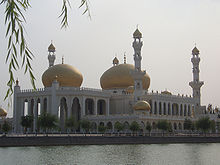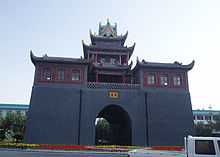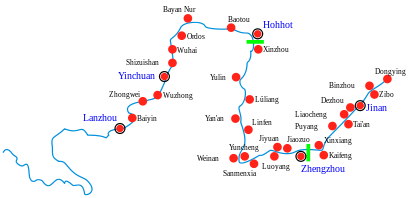Yinchuan
Yinchuan
银川市 · یٍچُوًا شِ | |
|---|---|
 | |
 The territory of Yinchuan prefecture-level city (yellow) within Ningxia | |
| Country | People's Republic of China |
| Region | Ningxia |
| Government | |
| • Mayor | Wang Rugui[1] |
| Area | |
| • Prefecture-level city | 4,467 km2 (1,725 sq mi) |
| • Urban | 2,045 km2 (790 sq mi) |
| • Metro | 2,045 km2 (790 sq mi) |
| Elevation | 1,100 m (3,608 ft) |
| Population (2010 census)[2] | |
| • Prefecture-level city | 1,993,088 |
| • Urban | 1,290,170 |
| • Urban density | 630/km2 (1,600/sq mi) |
| • Metro | 1,290,170 |
| • Metro density | 630/km2 (1,600/sq mi) |
| Time zone | UTC+8 (China Standard) |
| Postal code | 750000 |
| Area code | 0951 |
| License plate prefixes | 宁A |
| Website | www.yinchuan.gov.cn (Chinese) |
| Yinchuan | |||||||||||||||||||||||||||
|---|---|---|---|---|---|---|---|---|---|---|---|---|---|---|---|---|---|---|---|---|---|---|---|---|---|---|---|
 "Yinchuan" in Simplified (top) and Traditional (bottom) Chinese characters | |||||||||||||||||||||||||||
| Simplified Chinese | 银川 | ||||||||||||||||||||||||||
| Traditional Chinese | 銀川 | ||||||||||||||||||||||||||
| Literal meaning | "Silver River" | ||||||||||||||||||||||||||
| |||||||||||||||||||||||||||
Yinchuan is the capital of the Ningxia Hui Autonomous Region, China,[3] and former capital of the Western Xia Empire of the Tanguts. It has an area of 4,467 km2 (1,725 sq mi) and a total population of 1.99 million. Its built up area is home to 1,290,170 inhabitants spread on three urban districts.[4] The name of the city literally means "silver river"; the character for "river" (Chinese: 川; pinyin: chuān) is the same as that in Sichuan, but not as those in, for example, the Yellow River (simplified Chinese: 黄河; traditional Chinese: 黃河; pinyin: Huánghé) or Yangtze River (simplified Chinese: 长江; traditional Chinese: 長江; pinyin: Chángjiāng).
Thanks to the Yellow River, Yinchuan enjoys beautiful natural scenery and favorable conditions for agriculture and has long earned the fame of a "River Side City in the Northwest" and "Home to Fishes and Rice". Yinchuan is now the permanent site for China-Arab Expo which is an international platform for cultural and economic exchanges between China and Arab countries.
History
Yinchuan originally was a xian (county) under the name of Fuping in the 1st century BC; its name was changed to Huaiyuan in the 6th century AD. After the fall of the Tang dynasty in 907, it was occupied by the Tangut Xi-Xia dynasty, of which it was the capital.[5] After the destruction of the Xi-Xia dynasty by the Mongols in 1227, Yinchuan was mercilessly pillaged by the Mongols with its population totally slaughtered.[6][7] The Mongols called the city Iryai. Under the Ming (1368–1644) and Qing (1644–1911) dynasties, it was a prefecture of Ningxia. In 1928, when the province of Ningxia was formed from part of Gansu, it became the capital city. In 1954, when Ningxia province was abolished, the city was put in Gansu province; but, with the establishment of the Ningxia Hui autonomous region in 1958, Yinchuan once again became the capital. Genghis Khan died here in 1227, in a battle.
Traditionally, Yinchuan was an administrative and commercial center. In the 1950s it had many commercial enterprises, and there were some handicrafts but no modern industry. The city has since grown considerably. Extensive coal deposits discovered on the eastern bank of the Yellow River, near Shizuishan, 100 km (62 mi) to the north, have made Shizuishan a coal-mining center.
Yinchuan, however, remains largely non-industrial. The immediate plains area, intensively irrigated by a system developed as long ago as the Han (206 BC–AD 220) and Tang (618–907) dynasties, is extremely productive. Yinchuan is the chief agricultural market and distribution center for this area and also deals in animal products from the herds tended by nomads in the surrounding grasslands. It is a market for grain and has flour mills, as well as rice-hulling and oil-extraction plants. The wool produced in the surrounding plains supplies a woolen-textile mill. Yinchuan is a center for the Muslim (Hui) minority peoples, who constitute a third of the population. Yinchuan currently serves as a major trade route between Western cities such as Ürümqi and the East.
On 23 July 1993 an airliner that was attempting its second take-off veered off the runway, crashed into a lake, and broke apart; at least 59 of the 113 persons aboard the craft were killed.[8]
Geography

| Yinchuan | ||||||||||||||||||||||||||||||||||||||||||||||||||||||||||||
|---|---|---|---|---|---|---|---|---|---|---|---|---|---|---|---|---|---|---|---|---|---|---|---|---|---|---|---|---|---|---|---|---|---|---|---|---|---|---|---|---|---|---|---|---|---|---|---|---|---|---|---|---|---|---|---|---|---|---|---|---|
| Climate chart (explanation) | ||||||||||||||||||||||||||||||||||||||||||||||||||||||||||||
| ||||||||||||||||||||||||||||||||||||||||||||||||||||||||||||
| ||||||||||||||||||||||||||||||||||||||||||||||||||||||||||||
Yinchuan lies in the middle of the Yinchuan or Ningxia Plain. It is sheltered from the deserts of Mongolia by the high ranges of the Helan Mountains to its west. The Yellow River runs through Yinchuan from southwest to northeast. The average elevation of Yinchuan is 1,100 meters (about 3,608 feet). The urban center of Yinchuan lies about halfway between the Yellow River and the edge of Helan Mountains.
Climate
Yinchuan has a cold desert climate (Köppen BWk) with an annual rainfall of 186 mm (7.32 in). Yinchuan has distinct seasons, with dry, cold winters, late springs and short summers. The monthly 24-hour average temperature ranges from −7.9 °C (17.8 °F) in January to 23.5 °C (74.3 °F) in July, with the annual mean at 9.00 °C (48.2 °F). Diurnal temperature variation tends to be large due to the aridity, which also partly contributes to the sunny climate; with monthly percent possible sunshine ranging from 63 percent in three months to 71 percent in November, the city receives 2,906 hours of bright sunshine annually. There are 158 frost-free days.
| Climate data for Yinchuan (1971–2000) | |||||||||||||
|---|---|---|---|---|---|---|---|---|---|---|---|---|---|
| Month | Jan | Feb | Mar | Apr | May | Jun | Jul | Aug | Sep | Oct | Nov | Dec | Year |
| Mean daily maximum °C (°F) | −0.8 (30.6) |
3.5 (38.3) |
10.4 (50.7) |
18.9 (66.0) |
24.2 (75.6) |
27.8 (82.0) |
29.5 (85.1) |
27.6 (81.7) |
23.2 (73.8) |
16.7 (62.1) |
7.7 (45.9) |
0.8 (33.4) |
15.8 (60.4) |
| Mean daily minimum °C (°F) | −13.7 (7.3) |
−9.8 (14.4) |
−2.8 (27.0) |
3.9 (39.0) |
10.1 (50.2) |
15.1 (59.2) |
17.6 (63.7) |
16.2 (61.2) |
10.4 (50.7) |
3.1 (37.6) |
−3.2 (26.2) |
−10.3 (13.5) |
3.1 (37.5) |
| Average precipitation mm (inches) | 1.2 (0.05) |
2.3 (0.09) |
6.3 (0.25) |
8.3 (0.33) |
18.7 (0.74) |
17.4 (0.69) |
42.8 (1.69) |
51.5 (2.03) |
22.5 (0.89) |
11.5 (0.45) |
2.9 (0.11) |
0.9 (0.04) |
186.3 (7.36) |
| Average precipitation days (≥ 0.1 mm) | 1.2 | 1.4 | 2.3 | 2.6 | 4.1 | 5.6 | 7.9 | 8.7 | 5.7 | 3.4 | 1.4 | 0.8 | 45.1 |
| Average relative humidity (%) | 55 | 50 | 49 | 42 | 46 | 56 | 64 | 69 | 67 | 62 | 64 | 62 | 57 |
| Mean monthly sunshine hours | 205.7 | 201.1 | 232.6 | 255.5 | 287.1 | 285.3 | 281.8 | 267.2 | 240.2 | 231.9 | 214.3 | 203.1 | 2,905.8 |
| Percent possible sunshine | 68 | 67 | 63 | 65 | 65 | 64 | 63 | 63 | 65 | 67 | 71 | 69 | 66 |
| Source: China Meteorological Administration[9] | |||||||||||||
Administrative divisions
| Map | |||||||
|---|---|---|---|---|---|---|---|
| Name | Simplified Chinese | Hanyu Pinyin | Xiao'erjing | Population (2010) |
Area (km²) | Density (/km²) | |
| City proper | |||||||
| Xingqing District | 兴庆区 | Xīngqìng Qū | سٍشٍ ﺛُﻮْ | 678,306 | 768 | 883 | |
| Jinfeng District | 金凤区 | Jīnfèng Qū | دٍ ﻓْﻊ ﺛُﻮ | 282,554 | 290 | 974 | |
| Xixia District | 西夏区 | Xīxià Qū | ثِشیَا ﺛُﻮ | 329,310 | 987 | 334 | |
| Satellite cities | |||||||
| Lingwu City | 灵武市 | Língwǔ Shì | لٍءُ شِ | 261,677 | 4,639 | 56 | |
| Rural | |||||||
| Yongning County | 永宁县 | Yǒngníng Xiàn | ﻳْﻮنٍ ﺷِﯿًﺎ | 218,260 | 1,295 | 169 | |
| Helan County | 贺兰县 | Hèlán Xiàn | حْلً ﺷِﯿًﺎ | 222,981 | 1,600 | 139 | |
Economy
The city's gross domestic product per capita was ¥31,436 (US$4,526) in 2008, ranking 197th of 659 Chinese cities. Its main industries are the production of Chinese wolfberry, wheat, apple, rice, and wine.[citation needed] In 2010, Yinchuan is officially assignment as the site for China-Arab States Cooperation Forum. It provides great opportunities for Yinchuan to develop as the business center for China and Arab States. In the national level, Yinchuan has been holding various events such as China-Arab States Expo, to function as a business bridge between China and Arab States.
Transportation

- Yinchuan is located near the western bank of the upper course of the Yellow River, near the western end of the Great Wall of China in the south-central section of the Helan Mountains and Ordos Desert.
- It is served by Yinchuan Hedong Airport. It is 25 km (16 mi) from Yinchuan and has flights to Beijing, Chengdu, Dunhuang, Guangzhou, Shanghai, Xian, and Zhengzhou. Recently, flights have been introduced to Dubai by Sichuan Airlines and by early May, Emirates will be serving Yinchuan and flying onto Zhengzhou
- It is served by a river port at Hengcheng, about 15 km (9.3 mi) to the east. Until the 1950s the river, which is navigable downstream as far as Baotou in the Inner Mongolian autonomous region and upstream to Zhongwei and Zhongning, was the chief communication link.
- Highways also link the city to Baotou along the river, to Lanzhou in Gansu province to the southwest, to Wuwei in Gansu to the west, and to Xi'an in Shaanxi province to the southeast.
- Since 1958 the city has been on the railway from Lanzhou to Baotou and is thus linked to other parts of China by rail.
- China National Highway 211
- G69 Yinchuan–Baise Expressway
Tourism


The city's attractions include the Sand-lake, the Western Xia tombs, and the China Western film Studios.
Sand Lake is 35 miles north of Yinchuan. Being a world of desert and lake, it is an ideal place for bird watching, sand slide and cableway slide. Appreciating reeds, lotus and fish are also popular.
The Western Xia Imperial Tombs are 15.5 miles west of Yinchuan on east side of Mt. Helan. Since June 1972, nine imperial tombs and 253 lesser tombs have been unearthed, which are as grand as Ming Tombs in Beijing. With a total area of more than 19.3 square miles, it is unique among royal burials.
China West Film Studio,which has been famed as 'One Superb in China, and Treasure of Ningxia Province',is located at the east foot of the magnificent Helanshan Mountain,25 kilometers away from the Railway Station 0f Yinchuan City,48 kilometers away from the Hedong Airport. It produced The Herdsman, Red Sorghum, Lover's Grief over the Yellow River, New Dragon Gate Inn, Ashes of Time, A Chinese Odyssey, Qiao's Grand Courtyard (TV series) and other nearly one hundred films.
There are two pagodas in Yinchuan that are part of the 'Eight Famous Scenery of Ningxia': one is the Haibao Pagoda in the northern suburb and the other is the Chengtiansi Pagoda in the west.
It is also possible to see parts of the Great Wall which are located near the city.
Since 2000, Yinchuan has hosted the annual Yinchuan International Car and Motorcycle Tourism Festival, which usually occurs in August. It is the largest event of its kind in China; approximately 3000 motorcycles attend annually.
Colleges and universities
- Ningxia Polytechnical University
- Ningxia University
- Ningxia Medical University
- Second Northwest Nationalities University

See also
References
- ^ "Large Bearing Project of Schaeffler Group Started Construction in Yinchuan ETDZ" (Press release). Foreign Investment Administration, MOFCOM. 18 April 2008. Retrieved 17 July 2008.
Wang Rugui, Mayor of Yinchuan on behalf of the CPC Committee of Yinchuan and the municipal government expressed the warm congratulation to [sic] the start of the project.
- ^ According to 2010 China National Census
- ^ "Illuminating China's Provinces, Municipalities and Autonomous Regions". PRC Central Government Official Website. Retrieved 17 May 2014.
- ^ 银川市统计局 (29 December 2011). "银川市2010年第六次全国人口普查主要数据公报". 银川统计信息网 (in Chinese). 银川市第六次全国人口普查领导小组办公室. Retrieved 17 July 2015.
- ^ Jack Weatherford Genghis Khan and the Making of the Modern World, p.85
- ^ Mote, Frederick W. (1999). Imperial China: 900-1800. Cambridge, Massachusetts: Harvard University Press. p. 256. ISBN 0674012127.
- ^ Boland-Crewe, Tara and Lea, David, ed. (2002). The Territories of the People's Republic of China. London: Europa Publications. p. 215. ISBN 9780203403112.
{{cite book}}: CS1 maint: multiple names: editors list (link) - ^ 23 July Events in History
- ^ 中国地面国际交换站气候标准值月值数据集(1971-2000年) (in Chinese). China Meteorological Administration. Retrieved 4 May 2010.



